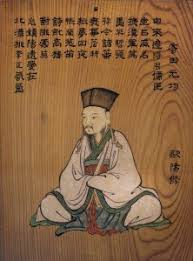Ngeou Yang Sieou and erotic prose.

Ngeou Yang Sieou and erotic prose. Ngeou Yang Sieou (歐陽修). Few people in mainland China (apart from the name), and even fewer in the West, know of Ngeou Yang Sieou (歐陽修), more commonly spelt Ouyang Xiu in the West. Literate Chinese prefer the name he gave himself: Ngeou Yang Tsouei Wong (drunken old man). NYS was a leading politician among the Northern Songs, who rose to the top of the Chinese civil service in the 11th century on the strength of his literary skills alone (he was a self-taught orphan). He became a famous writer, as well as a scholar, essayist, poet and official imperial editor. Although he is best remembered for his poem The Drunken Old Man, NYS was a true genius who laid the foundations of neo-Confucianism, particularly the Shenxiao* school of the Tao, which preaches rationalism and uncompromising anti-Buddhism.
His literary style also opened the door to the Guwen style (古文运动) and the Song poetic style. His works are of great force and beauty, transcending the limits of time and eras. NYS was also one of those who knew how to write erotic poetry without falling into either vulgarity or censorship. It was in exile, far from the constraints of virtue that a high official had to demonstrate at court, that he began to write these carnal poems. When he was dismissed from his official duties at court following the failure of the political reform of 1045, his political opponents claimed that he had committed adultery with his biological niece, Kang. This scandal led the emperor to send him into exile. However, in Chinese erotic poetry, the female body is never explicitly described, and the breasts are the least explicitly described part.
NYS broke this taboo in exile. His finest erotic poem is undoubtedly ‘系裙腰’, which can be translated as ‘The Tie Knotted at the Waist’. This poem is explicitly about the whole dating process of the upper-class men and women of the Songs period.
There are many ways to translate Chinese, which is a nuanced and contextual language, which means that the meaning of sentences and the choice of words is directly linked to an idea and an era. So using online translation engines is not the best way to go about it. Here is an extract from the said poem and its historical contextual explanation. You can try copying and pasting it into Google translate to get an idea of the big difference between my translation and the one it offers, from the title to the extract.
水轩檐幕透薰风。
银塘外、柳烟浓。
方床遍展鱼鳞簟, à碧纱笼。
小墀面、对芙蓉。
玉人共处双鸳枕,和娇困、睡朦胧。
起来意懒含羞态,汗香融。
素裙腰,映酥胸。
系裙腰。
Free translation:
Under the awning of the pavilion on the water, the curtains let in the fragrant breeze. Beyond the silvery pond, the smoke from the willows thickens. The bamboo bed is covered with a straw mat in the shape of fish scales, and blue tulle envelops it. The small stoop faces the lotus flowers. Beside the beauty, sharing a pillow embroidered with mandarins*, they sleepily abandon themselves to a gentle torpor. I feel lazy and shy when I wake and my sweat is fragrant.
‘玉人共处双鸳枕,和娇困、睡朦胧’ means that the two lovers fell asleep hugging each other after making love and “系裙腰” means that after waking up, the man admired the naked body of the woman.
To know all the nuances of these poems, you naturally had to be a scholar with a mastery of many hanzis**. To decipher the meaning of the poem, the reader had to be initiated into the traditions of the poetic game of the period under study, into the habits of the particular language that Chinese poets passed on to each other.
EmbunDH.
Notes:
*There were many schools or sects within Taoism, which eventually came to be grouped into two branches or great schools of thought. The school of Shinxiao (also known as the Way of Thunder), in addition to preaching anti-Buddhism and political rationalism, helped enormously in building a form of divinity for the central feudal organisation. It also had the particularity of having adopted numerous rural esoteric rites and its followers practised many magical rituals, making this school one of the most interesting to discover. Today, it is still present in Singapore and Taiwan as part of the Shan school.
**Embroidery marking the rank of the holder on his clothes, sheets and bedding.
*** Sinograms.
